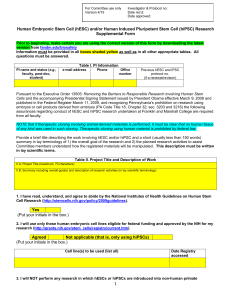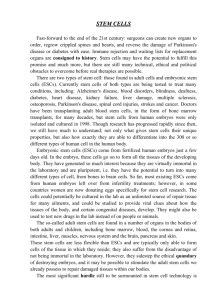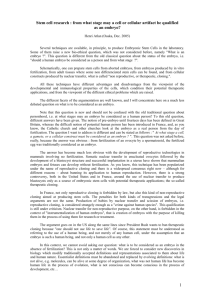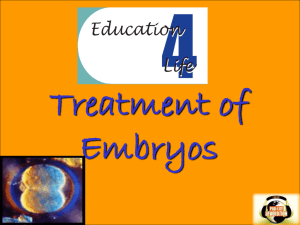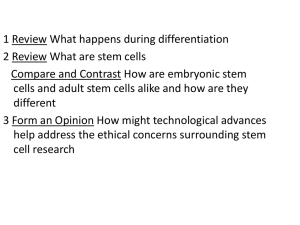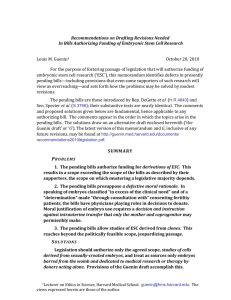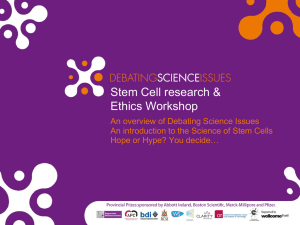Obscurum per obscurius: Why the stem cell debate is such a mess
advertisement
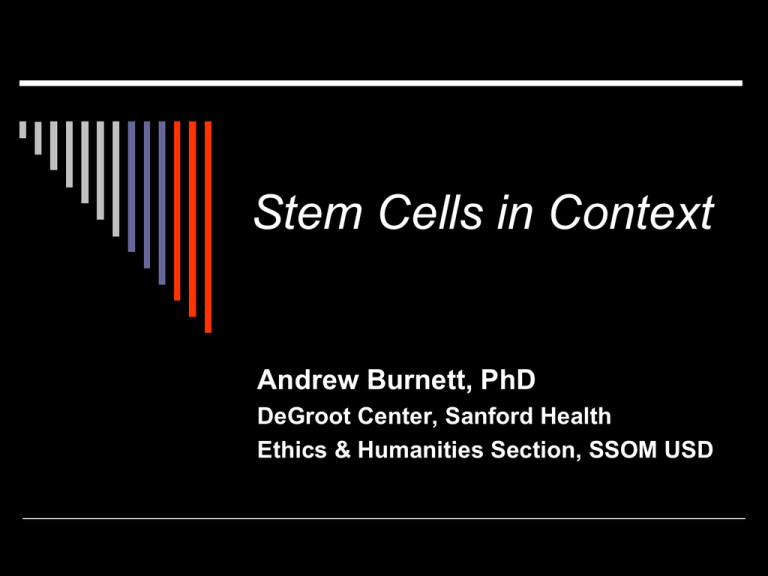
Stem Cells in Context Andrew Burnett, PhD DeGroot Center, Sanford Health Ethics & Humanities Section, SSOM USD Overview Basic science of stem cells Some possible biomedical applications The federal funding issue Regulating stem cell research Political and cultural angles Ethical perspectives Basic science of stem cells Embryonic stem cells Obtained from blastocyst stage Can be cultured as undifferentiated cell lines… …or directed to develop into differentiated cells Pluripotent: can become any cell type ESCs via Nuclear Transfer Genetic material from oocyte replaced with nucleus from “adult” somatic cell Resulting ESC line is a clone of the donor Can also be used for reproductive cloning (no humans so far…) ESCs via PGD techniques? Single cell can be harvested from morula stage, then cultured into an ESC line Similar technique used for pre-implantation genetic diagnosis Embryo remains viable in most cases Sources of “adult” stem cells Bone marrow (hematopoetic cells) Umbilical cord Other adult tissues Potency of some ASCs is limited to specific tissue types Other ASCs are multipotent ASCs an alternative to ESCs? Autologous source has similar clinical advantages to NT Safety and ethical concerns may favor ASCs for many applications ASCs may be “reprogrammed” to ESC-like state: how close to ESC functionality is not known Rancor of debate makes objective assessment difficult Possible applications: research Test bed for developmental biology Combine with NT cloning to study genetic effects New model for testing drugs / toxic effects Possible applications: clinical Regenerative medicine (skin, circulatory, neurological) Diseases involving injury / cell death of specific tissue types (type 1 diabetes, Parkinson’s) Spinoffs from ESC research Federal regulation OHRP jurisdiction: NIH-funded research FDA jurisdiction: Investigational drugs/therapies or supporting research IRB/ESCRO approval—institutions may voluntarily apply federal standards to non-federally funded research Private research largely unregulated State regulation The federal funding debate Clinton administration 1998-2000: NIH approves funding (modest amount) Policy expected from Gore Administration Bush administration 2001: Approves NIH funds for existing cell lines only State initiatives: NJ, CA, others 2006: Bush vetoes federal funding expansion (1st use of his veto power) Obama administration April 2009: Reverses Bush executive order August 2010: Federal appeals court injunction citing DickeyWicker Amendment November 2010: Justice Dept. appeals court decision Subjects protection approach Standard principles of research ethics Informed consent Benefits justify risks Protect “vulnerable” research populations Protections for fetuses and fetal tissue Concerns about integrity of consent Benefit claims: the “therapeutic misconception” NAS stem cell guidelines (2005, revised 2007) Emerging de facto standard for private and much state-sponsored research ESCROs must review when New ESC lines will be created ESCs will be introduced into nonhuman animals at any stage Donor identity is known or ascertainable Investigators must show “compelling rationale” for using ESCs in research NAS guidelines: debatable issues Not permitted: IV embryo culture past 14 days, hESCs introduced into primate blastocysts (including humans), allowing chimera organisms to breed Permitted: most chimeras, NT cloning for research, creating embryos for research Not covered: reproductive cloning (NAS separately opposes “at this time”) Political/cultural angles on the funding controversy The long shadow of the abortion issue For Bush: Chance to set pro-life policy by executive order For Democrats: Stem cells as a wedge issue (many GOP voters favor funding) Political/cultural ironies Paradoxes of the funding-regulation link 1981 “ban” not a true ban, but encouraged privatization and de facto deregulation Private funding promotes a “Wild West” atmosphere in fertility medicine Political polarization makes federal legislation unlikely (e.g. cloning ban) IVF has quietly produced 500,000+ “left over” embryos in cold storage Advocacy trends Terminology is key: “Therapeutic” vs. “reproductive” cloning Blastocysts don’t sound cuddly Importance of disease-based advocacy Celebrity spokespeople Emphasize treatment, not pure research Compassion as trump card Pause Nascent human life in ethical perspective Until recently, few of us gave much thought to the life forms whose fate we are now being asked to decide. What concepts, experience, and imagination can we bring to bear on the decisions we are being asked to make? Personhood of nascent humans: 3 approaches 1. Personhood is decisive, and the very early human embryo is a person. 2. Personhood is decisive, and the very early human embryo is not a person. 3. Personhood is not decisive. We cannot resolve disagreement about whether the very early human embryo is a person; and personhood does not settle the issue in any case. Position 1: Blastocysts are persons Personal life begins at conception Does not exclude all ESC research Cell lines from nonviable embryos Existing cell lines Status of “left over” embryos that will be discarded if not used for research What about other ways to produce blastocysts without “conception”? Position 2: Blastocysts are not persons Conception begins a human life, but not the life of a person Respect for humanity in itself Potential vs actual personhood What is a “potential person”? What about intentionally halting or redirecting development? Does this justify creating human embryos solely for research? Position 3: Personhood is not the decisive issue Recognizes metaphysical as well as moral uncertainty Some ESC research may be OK even if blastocysts are persons; some may be unethical even if they are not May appear conceptually and morally “soft” to advocates of positions 1 and 2 Coherence of attitudes Moral weight or “considerability” accorded to all human life What is our ordinary attitude towards nascent human life? What is the cost of altering this? Commodification concerns Why do we have kids? Indirect duties: what kind of people do we become? Questions to consider Why the accumulation of frozen embryos from IVF? Why the intuition that it is better to use “leftover” embryos than create new ones for research? Why so little discussion of IVF implications between 1978-1998?
